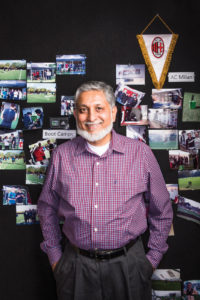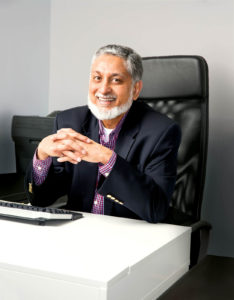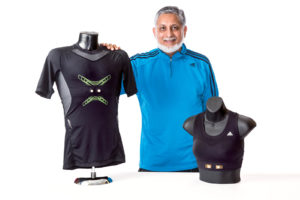
Qaizar Hassonjee mines market opportunities and forms partnerships to bring smart fabrics to market.
“The intersection of textiles and technology is a huge untapped opportunity for the textile industry,” says Qaizar Hassonjee, senior director, business development and partnerships, for adidas Digital Sports. “Market segments such as hospitality, health care and military are really prime for smart textile innovations. Once you’ve got the innovation and technology, however, it’s the application and business model that either makes or breaks a business.”
Early in 2005, after several years of working for Wilmington, Del.-based DuPont (in R&D, technical marketing, sales and marketing and business development), Hassonjee founded smart fabrics company Textronics Inc. with partner Stacey Burr. The two had been working on a core technology platform for smart textile applications when they decided to launch their own business. “At that time we had a lot of these intellectual properties and core technologies and were looking at a lot of different applications,” Hassonjee says. “Our original business model was to sell the materials or yarns and then the industry would build the products. But we soon realized that the technology was so new and innovative that we would have to teach all of the [manufacturers] how to do it, and we didn’t have the wherewithal for that. So we chose to take it to one application ourselves.”
From start-up to adidas
That application turned out to be the first heart rate-monitoring sports bra, which they launched in December 2005. Before Hassonjee and his partner launched the product into the sports market they considered many different market segments for the application, including medical, health care, military and first responder. Because most of those market segments are heavily regulated, however, the two settled on launching the product to the sports market. “That was the first time a smart textile application was on a consumer level at a consumer price point,” Hassonjee says.
From a market standpoint, the launch was a sensation, and the heart rate-monitoring sports bra received a tremendous amount of publicity, along with demand for variations on the product. Big players in the sports apparel world such as Reebok and adidas approached Textronics to explore ways to develop the same technology for the elite sports market. In 2008 adidas acquired Textronics, and Hassonjee became vice president of innovation for what is now its Digital Sports business. “As a smaller and resource-limited company, we did not have a significant brand or global distribution,” he says. “Adidas acquired the company for the technology and the team.”
During his years at adidas, a shift occurred for the company in terms of how it developed products within the smart textile market. Instead of a technology-forward approach, the innovation team became more market focused. “We began to talk to people in pop culture, and athletes and trainers in the world,” Hassonjee says. “We asked them what their pain points were and how they could become better at what they do, and based on that we looked at the right technology components so they could get it.”
 More than just data
More than just data
In 2015 Hassonjee’s responsibilities shifted from innovation to business development and partnership, a role he’s enthusiastic about. “Until recently, adidas was doing everything on its own,” he says. “For example: our core systems. Our sensors, apparel, electronics and our ecosystem were all closed. We saw a bigger opportunity if we opened it up and invited others to either build experiences on our products or create experiences based on data that is generated by other sensors for sports applications.”
In his new role, Hassonjee is looking at this whole space of the intersection of textiles and technology for sports-related applications and a little beyond, in terms of fitness and well-being. Adidas’ Digital Sports business has a good number of sensors and products, and Hassonjee and his team have developed and built in capabilities for them in terms of the analytics, which he points out is a critical component to creating the best experience for the user. “People were saying: ‘Don’t come back to me with more data because I don’t have any more time to look at sheets and sheets of data,’” he says. “It’s important to take the data that the sensors generate and analyze it for insights.”
For example, consumers are asking for more from smart apparel than just collecting data on how they’re running and how much distance they’ve covered. They want to know what that information means. They want to know what the mechanical power is they’re putting out. How much heart-load do they have? And based on that, they want insights.
“Take the mechanical power for an athlete and look at the heart-rate load in terms of what’s happening to the body because of the mechanical power they’re putting out,” Hassonjee says. “If one player is putting out more mechanical power than the other but his or her heart-rate load is slower, it means that player is more physically fit than the other player. Heart-rate load is an indication of fatigue, and whenever a person starts to get fatigued either their performance goes down or—more importantly—they’re more susceptible to injury. That’s a valuable insight to the users.”
 Power in pairs
Power in pairs
When Hassonjee and his team are looking for a technology that makes that experience happen for the user, they look at who’s got the technology that might be a match. Adidas might have technology in-house that the team could use as-is or modify it. Or they might look at some start-ups, to companies in adjacent markets, or to academics. “Academics have great fundamental core technologies,” he says. “Those technologies typically need some development to commercialize them, and we are able to bridge that gap very successfully.”
Hassonjee says the challenge happens when it comes time to turn technology into something that’s ready for commercialization. “Often the technology is a good fundamental backbone, but it needs a lot more development and testing before it gets to commercial use because you want the experience to be as smooth as possible for the user. Once the user runs into any problems with the technology, you know he or she will give up on it very quickly. Getting 80 to 90 percent of the way there is the easy part. Finishing that last 10 to 20 percent is what takes the time.”
Building partnerships can also take time, and aligning priorities is among the challenges. Hassonjee points out that sometimes the parties don’t share priorities in terms of how fast they want to see the product come to market, and that kind of a mismatch can be problematic. “When we were a start-up company with the sports bra, that was our number one priority,” he says. “At that time we were working with Champion, and it was probably their 8th or 10th priority. For them, if it happened or not—fine. For our company, it was life or death. You don’t want that kind of mismatch.”
Hassonjee is confident that the possibilities for textile and technology applications cross market segments and provide a tremendous opportunity for others in the specialty fabrics world. His advice for anyone wanting to enter the market? “Immerse yourself in the endeavor and make a commitment to it.”
As he develops partnerships, he tries to make sure all the people involved understand what it takes to make smart textile applications effective and accessible. “This intersection of textiles and technologies is a constant learning and evolving process,” Hassonjee says. “I’m changing and evolving as the technology evolves—and it’s very exciting.”
 Snapshot: Insightful shirt
Snapshot: Insightful shirt
In 2013, adidas launched the miCoach Elite Team System, the first system of its kind that uses physiological data in real time—sending it straight to a coach’s tablet on the sideline. The system not only provides real-time insights during training, but tracks total training impact, collects and manages data and is highly portable. The state-of-the-art system measures everything from power, speed and distance to heart rate, acceleration and field position, allowing key insights into player performance and work rate, helping teams achieve and maintain peak physical performance.
The techfit shirt is designed for comfort and features integrated heart rate sensors, sleeveless style and sweat-wicking fabric—and it’s machine washable. The intuitive user interface has an easy-to-understand display, and the PC technology and Internet connectivity are available in both Wi-Fi and hardwire options. “This is a great example of how we can use a combination of textiles and technology/electronics to bring new experiences within the vertical market that we’re a part of,” Hassonjee says.
5 top tips for bringing smart textile products to market
- Make sure that whatever you’re doing is bringing an experience downstream that has value.
- Look both internally and externally to find (and/or modify) the right technology to make the experience happen.
- Develop and test the product so the technology adapts to how humans behave, and not the other way around.
- Manage the supply chain so the product’s value for the consumer
is much higher than the cost. - Understand that bringing smart textiles to market takes commitment.
How can IFAI help its membership take advantage of smart textile opportunities?
I’m on IFAI’s Advanced Textiles Products board, and before that, when it was called Safety and Protective Products. Each and every annual meeting, we make sure that during the day we have at least one conversation around smart textiles and the intersection of textiles and technology. We are sponsoring students in the student contest. My focus as a board member is to see how I can help bring more business happening around smart textiles.
What are some of the possibilities for smart textile applications outside of the sports market?
These same technologies that we’re using for sports applications are very applicable in health care, senior living and geriatrics, as well as for hospitality and the military. For example, in hospitality, you can bring benefits to the user in terms of comfort. For health care, you can start monitoring things that would be helpful for the nurses to know, such as vital signs. Or you could do tele-health monitoring. The same things apply for the military.
 TEXTILES.ORG
TEXTILES.ORG


